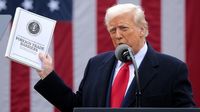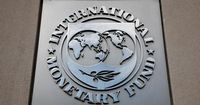The International Monetary Fund (IMF) has released a new report forecasting significant economic adjustments in the United States due to the implementation of steep tariffs by the Trump administration. The report, titled Fiscal Monitor, highlights that while these tariffs may help lower the U.S. fiscal deficit slightly in 2025, they also pose risks to economic growth and inflation.
According to the IMF's findings, the overall federal deficit is projected to decrease to 6.5% of gross domestic product (GDP) this year, down from 7.3% in 2024. This reduction is contingent upon increased tariff revenues, as stated in the report published on April 23, 2025. The calculations were made based on tariff announcements up to April 4, which include reciprocal tariffs introduced on April 2, but do not account for subsequent developments such as a 90-day pause on higher rates and exemptions for certain technology goods.
The IMF's projections suggest that the deficit could further decline to 5.6% of GDP in the medium term, as revenues are expected to rise by 0.7%. However, the report also cautions that "the magnitude of the tariff revenue increase is highly uncertain." Factors such as consumer response to higher prices and the overall tariff schedule will significantly influence this outcome.
As the trade war escalates, the IMF has expressed concerns about the broader economic implications. The organization warns that tariffs could lead to a slowdown in economic activity, which might adversely affect other tax revenue streams, such as income tax. The report states, "These projections are highly uncertain and do not account for measures under discussion in Congress, under budget reconciliation negotiations."
In recent weeks, yields on the benchmark 10-year Treasury note have surged, trading near 4.40%. This increase is attributed to the announcement of higher tariffs, rising inflation forecasts, and a declining dollar. The IMF noted that if U.S. government debt continues to grow, it could lead to higher long-term interest rates and increased financing costs. Specifically, an increase of 10 percentage points of GDP in U.S. public debt between 2024 and 2029 could result in a 60-basis-point rise in the 5-year forward to 10-year rate.
On a global scale, the IMF's report indicates that economic pressures from U.S. tariffs will push global public debt above pandemic-era levels, potentially reaching nearly 100% of global GDP by the end of the decade. The IMF projects that global public debt will increase by 2.8 percentage points to 95.1% of GDP in 2025, with a continued upward trend expected, culminating in 99.6% of global GDP by 2030.
"Major tariff announcements by the United States, countermeasures by other countries, and exceptionally high levels of policy uncertainty are contributing to worsening prospects and heightened risks," the IMF stated. This situation complicates fiscal management for governments, as they face rising defense spending needs, demands for social support, and increasing debt service costs due to inflationary pressures.
Despite the challenges posed by tariffs, the IMF forecasts a slight improvement in U.S. annual budget deficits over the next two years. The report anticipates deficits of 6.5% of GDP for 2025 and 5.5% for 2026, compared to 7.3% for 2024. This improvement is attributed to a combination of increased tariff collections and continued growth in the U.S. economy. IMF Fiscal Affairs Director Vitor Gaspar commented, "The performance of the U.S. economy has been strong in recent years, and that helps the budget. It helps in the U.S., it helps everywhere."
However, this forecast hinges on the expiration of Republican tax cuts passed in 2017, which are expected to add $4 trillion to U.S. debt over a decade if extended without offsets. Meanwhile, China's fiscal deficits are predicted to grow sharply in 2025, reaching 8.6% of GDP, up from 7.3% in 2024, as the country implements economic stimulus measures to counteract the negative impacts of tariffs.
In the context of ongoing global economic negotiations, senior officials from multiple countries are meeting in London to discuss a potential ceasefire between Russia and Ukraine. The U.S. will be involved in these discussions, although key figures such as Secretary of State Marco Rubio will not participate. This diplomatic effort comes amid rising tensions and a need for a resolution to the conflict.
Additionally, the economic landscape is further complicated by the recent passing of Pope Francis, whose body was moved to St. Peter's Basilica on April 23, 2025, to lie in state. Mourners will have the opportunity to pay their respects for three days before his funeral, expected to draw hundreds of thousands of attendees.
As the IMF continues to monitor these developments, it remains clear that the interplay between tariffs, economic growth, and fiscal policy will define the financial landscape in the coming years. The organization urges countries to prioritize public debt reductions to build fiscal buffers against future economic shocks, emphasizing the need for balanced policy approaches.
In conclusion, the situation remains dynamic, with the potential for both positive and negative outcomes as nations navigate the complexities of trade, economic growth, and fiscal responsibility. The implications of these developments are likely to resonate far beyond the immediate financial indicators, affecting global markets and economies for years to come.






